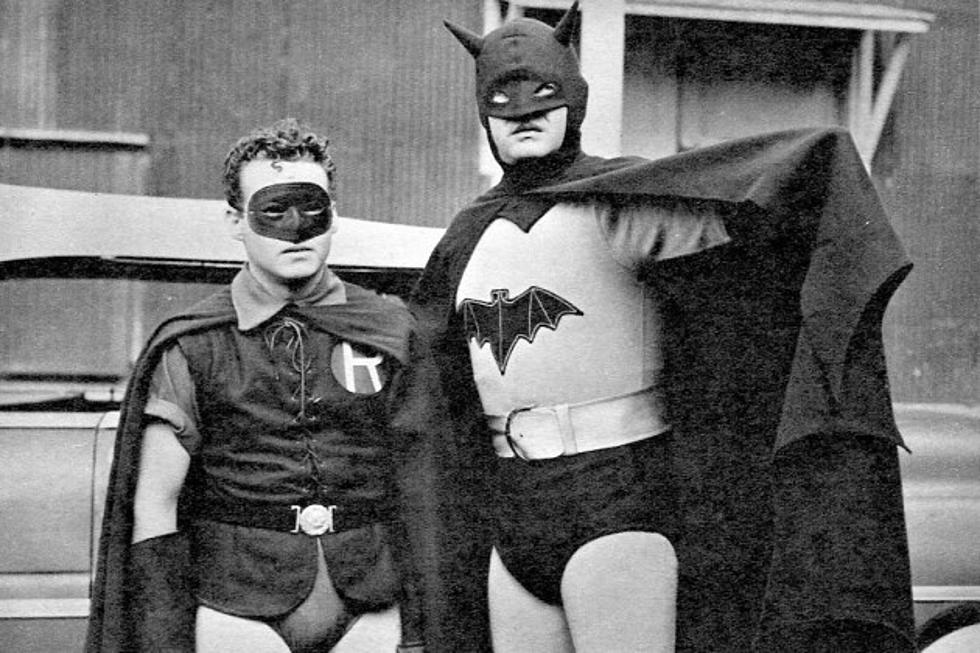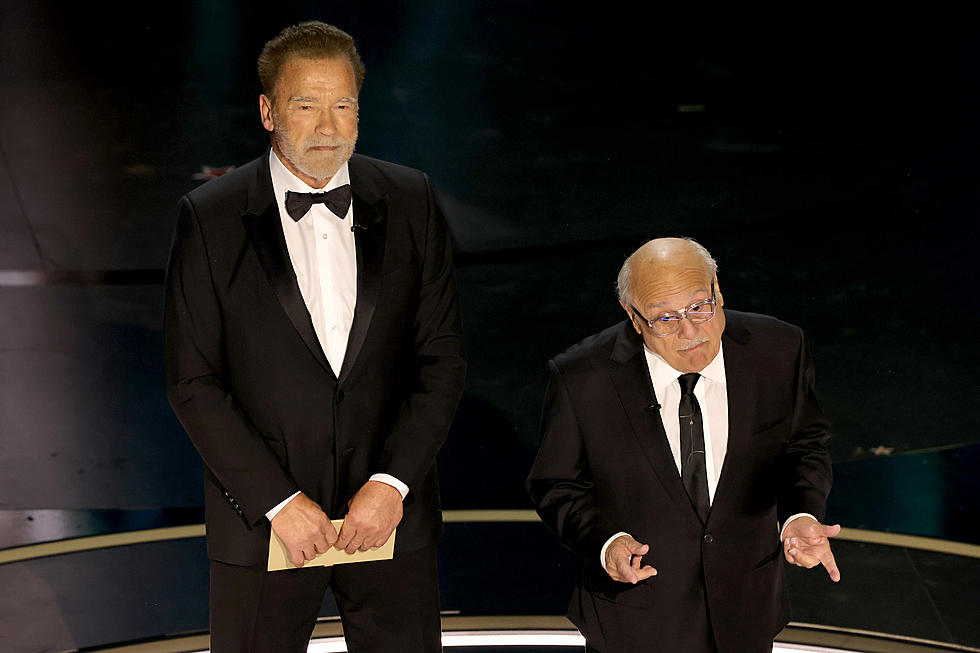
The Complete History of Comic-Book Movies, Chapter 9: ‘Batman and Robin’ (1949)
ScreenCrush editor, comic-book lover, and undiagnosed masochist Matt Singer is systematically watching every single (American) comic-book movie ever made in the order in which they were released. This week in The Complete History of Comic-Book Movies: The Dynamic Duo return, in decidedly less than dynamic fashion.
Batman and Robin (1949)
Director: Spencer Gordon Bennet
Writers: George H. Plympton, Joseph F. Poland, Royal K. Cole
Starring: Robert Lowery, Johnny Duncan, Jane Adams
Based on: Batman, created by Bob Kane and Bill Finger, in Detective Comics #27.
Onscreen Iteration: Second appearance.
The Best Special Effect: Batman and Robin follows the epic battle between the Caped Crusader and “The Wizard,” a masked villain who’s acquired a device that can remote control any motor vehicle in Gotham City. Early in the serial, Batman (Robert Lowery) and Robin (Johnny Duncan) trail the Wizard’s goons to a train where they hope to acquire some experimental explosives. Batman pulls up alongside the train in his convertible (there’s no Batmobile in this serial, sadly), jumps aboard, climbs a ladder, and begins punching it out with the bad guys on the top of the train. A few of these shots are done on a studio with rear projection, but plenty of them are legit: a stunt double, a moving train, and a speeding car.
Even some of the shots on the top of the train are authentic.
This is exactly the Batman I want to see onscreen: Brave and daring with a flagrant disregard for his own safety.
The Worst Special Effect: Does Batman’s costume count as a “special effect”? Because if it does, then the worst special effect is Batman’s costume.
This is exactly the Batman I don’t want to see onscreen: Looking like hot garbage.
Just in case it doesn’t count, I’ll give you another example. Batman and Robin hang out in the Batcave (which was actually invented by the previous Batman serial from 1943). The Wizard hangs out in his own secret cave lair, hidden beneath another wealthy man’s mansion.
The notion of an evil version of Batman is an intriguing one. Through most of the serial, the Wizard appears to be Professor Hammil (William Fawcett), the inventor of the remote-control device. Hammil is a near-perfect doppelganger for Bruce Wayne: He lives in an enormous estate on a hill with his own butler to attend to all his needs (along with that hidden, high-tech cave beneath his house). He’s an ideal antagonist and dark mirror image for our hero.
There’s just one problem: The producers clearly couldn’t afford two different subterranean hideouts, so they just built one and then redressed the set two different ways. Here’s the Batcave:
And here’s the Wizard’s Cave (note the exact same secret door to the far right and identical rock formation directly beside it):
Holy double vision, Batman!
(A runner-up Worst Special Effect for the movie’s version of the Bat-Signal, which inexplicably works in broad daylight:)
Most Dated Moment: Like so many serials, Batman and Robin was shot in and around the deserts of Southern California. The locations were cheap and offered plenty of space for chases, fights, stunts, and special effects. (They also helped ease the burden of maintaining continuity, allowing the crew to shoot scenes even quicker.) The desert did provide a few striking visuals, like this one of Batman atop a rocky cliff:
But desert locations like that one are extremely costly and difficult to light at night, which means Batman and Robin takes place almost entirely during the day. Batman’s whole schtick is lurking in the shadows, which is kind of tough to do in the middle of nowhere in bright sunlight. It’s hard to imagine any Batman movie in the post-Burton, post-Nolan era making that choice.
Most Timeless Moment: Batman doesn’t get many cool moments in this serial (I mean, just look at him) but he does have one killer sequence worthy of a much better film. He corners one of the Wizard’s men, who spins on his heels and socks Batman right in the jaw. Batman doesn’t flinch, then sarcastically quips “That hurt!” Then he punches the thug in the mouth and drops him like a sack of potatoes. Bad. Ass.
Further Thoughts: Batman & Robin is a significant piece of comic-book movie history for two reasons:
1) It’s the first comic-book movie sequel ever made. Many would follow.
2) It’s the first terrible comic-book movie sequel ever made. Many would also follow.
Nearly everything about Batman & Robin is worse than 1943’s Batman. The sets are hokey and obviously recycled for multiple locations, there are constant goofs and continuity errors, and Batman’s costume looks like it was made by a drunk or someone with a vendetta against him. Robert Lowery (Bat)phones in his performance and Johnny Duncan delivers his lines with all the enthusiasm of a death-row inmate ordering his final meal. On the plus side, Batman and Robin is not shockingly and despicably racist towards the Japanese. So it’s got that going for it.
Yes, Batman & Robin is bad but at least it’s hilariously bad; a nice change of pace from a lot of the boringly bad serials from this period of comic-book movie history. It’s pretty clear this film was shot on the cheap and the quick, with very little time given or attention paid to continuity or even fundamental notions of logic. Some of the mistakes are really funny. For most of the serial’s 15 chapters, the prime suspect for the true identity of the Wizard is Professor Hammil. Time and again, Batman and Robin consider the possibility that Hammil could be masquerading as the dastardly evildoer. And time and again Batman eliminates him from suspicion because Hammil is confined to a wheelchair and the Wizard is not. Still, the clues keep pointing in Hammil’s direction, so Batman and Robin eventually head to his mansion to confront him. And, naturally, when they do, he looks like this (that’s him between Batman and Robin):
Yes, the man they’re convinced can’t be the Wizard purely because he can’t walk is walking. And do Batman and Robin make note of this shocking turn of events? No, they do not. Isn’t Batman supposed to be the world’s greatest detective? Shouldn’t he observe his prime (paraplegic) suspect mysteriously walking around? That seems like a pretty important twist. Even Inspector Clouseau would have noticed that little detail.
Many of the filmmakers’ choices are just baffling. Batman and Robin keep their costumes in a filing cabinet in the Batcave. Not a clothes closet, not a dresser or a chest of drawers, a freaking filing cabinet. Who puts their clothes in a filing cabinet?!? No wonder their costumes look so bad. Bruce Wayne is the richest guy on the planet. He can’t afford a couple wire hangers?
There’s also a strange running theme about Batman getting electrocuted. In 15 chapters, where it’s necessary to come up with 15 different ways to almost kill Batman, it’s not that out of the ordinary to throw in one electrocution. But three? First he gets shocked by this metal bar thing:
Then he gets zapped when he slams into this high-tech gadget:
Then he fries a third time when the Wizard sends an electrical charge through his entire base, and Batman touches a metal doorknob.
Did the screenwriters just run out of ideas? Did they feel like they were not getting their money’s worth out of the electrocution lightning bolts special effect? This doesn’t make any sense. And Batman, I don’t know how else to say this: You suck. How many times do the bad guys have to electrocute you before you learn to insulate your suit? Better yet: Just stop touching things crackling with electricity! C’mon man. You’re supposed to be a superhero!
Gross incompetence aside, this is a very different Batman than the one modern moviegoers have grown to love in the work of Tim Burton and Christopher Nolan. Their Batmen are all extremes and intensity, heroes who will stop at nothing to avenge the death of their parents and others they’ve loved and lost at the hands of criminals. Batman’s origin or motivation never comes up in the four hours of Batman & Robin; if Robert Lowery’s Caped Crusader is still hurting from the loss of his parents, he certainly doesn’t mention it, and while he’s certainly driven to catch the Wizard, he acts more like a police officer with a garish uniform (working directly with Lyle Talbot’s Commissioner Gordon) than a deranged vigilante.
Modern Bat-fans associate the title Batman & Robin with one of the character’s most disastrous media appearances: Joel Schumacher’s goofy 1997 feature starring George Clooney as Batman and Arnold Schwarzenegger as a pun-loving Mister Freeze (“What killed the dinosaurs? The Ice Age!”). Curiously, there’s a weird synchronicity between the old Batman and Robin and the modern one. In both films, the villains need to steal diamonds to fuel their experimental machines. And, of course, both movies are absolutely and entertainingly awful. Clearly the Batman and Robin title is cursed, and should never be used again by the Bat-franchise, at least by anyone looking to make a serious version of the character who fights crime in exciting, competent fashion and hangs his costume in a closet like a normal human being.
Batman and Robin is available on DVD.
The Complete History of Comic-Book Movies Archive
-Adventures of Captain Marvel (1941)
-Spy Smasher (1942)
-Batman (1943)
-Captain America (1944)
-Hop Harrigan (1946)
-The Vigilante (1947)
-Superman (1948)
-Congo Bill (1948)
More From ScreenCrush









